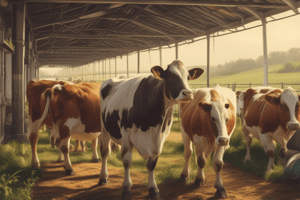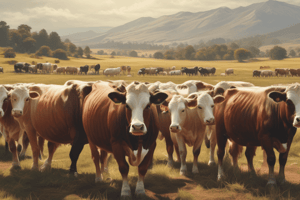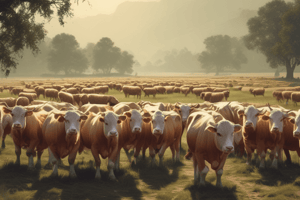Podcast
Questions and Answers
What are the three major outputs of dairy farming?
What are the three major outputs of dairy farming?
- Milk, cheese, and yogurt
- Milk, butter, and yogurt
- Milk, meat, and eggs
- Milk, meat, and calves (correct)
What is the most significant cost category associated with dairy diseases?
What is the most significant cost category associated with dairy diseases?
- Feed costs
- Treatment costs
- Culling costs
- Milk loss, treatment costs, and culling costs (correct)
What is the optimal calving interval for dairy cows?
What is the optimal calving interval for dairy cows?
- 16 to 17 months
- 12 to 13 months (correct)
- 10 to 11 months
- 14 to 15 months
Which of the following is a direct effect of disease in dairy cows?
Which of the following is a direct effect of disease in dairy cows?
What is days open (DO) a major indicator of?
What is days open (DO) a major indicator of?
Which of the following is NOT a common dairy disease?
Which of the following is NOT a common dairy disease?
What is a significant cost associated with mastitis due to its impact on milk production?
What is a significant cost associated with mastitis due to its impact on milk production?
What is a management cause of mastitis?
What is a management cause of mastitis?
Which statement about subclinical mastitis (SCM) is true?
Which statement about subclinical mastitis (SCM) is true?
What can controlling mastitis improve in dairy cows?
What can controlling mastitis improve in dairy cows?
Flashcards are hidden until you start studying
Study Notes
Dairy Production Losses
- Dairy production losses are mainly due to milk, meat, and calf production decrease, and can be a result of disease, management failures, genetic limitations and other factors.
- Disease effects milk production by decreasing quantity and quality, affecting reproductive performance (calving interval, milk production, number of offspring) and meat quality.
- Management failures can lead to disease and increase risk of mortality.
- Dairy diseases influence profitability directly through lost milk production and reduced growth, as well as through reproductive performance decline and less efficient feed conversion.
- Disease indirect effects include lowered production quality, shorter productive lifetime, higher treatment costs
Dairy Disease Costs
- Dairy diseases have variable cost depending on the region, farm, and the animal.
- Total disease cost is determined by adding the losses associated with production decline and the treatment expenditures.
- Mastitis, lameness, and reproductive failure are the most expensive health issues in the dairy industry.
- Optimal calving interval is between 12 to 13 months, and "Days open" (time between calvings) is a significant indicator of that interval.
Mastitis
- Mastitis is an inflammation of the udder that causes economic losses due to decreased milk production, treatment costs, discarded milk, veterinary services, labor costs, and culling.
- Management practices contribute to mastitis, including prolonged milking times, unclean bedding, and improper hand milking techniques.
- Pathogenic bacteria like Staphylococcus aureus and Streptococcus agalactiae are the most frequent cause of mastitis.
- Subclinical mastitis is associated with elevated somatic cell count (SCC) in milk, a decrease in milk production, and changes in milk composition.
- Clinical mastitis can be recognized by visible signs like clots in milk, udder swelling, and fever.
- Mastitis impacts milk production by destroying the alveoli (where milk is produced) in the mammary gland.
- Mastitis also negatively impacts reproductive performance due to endotoxins from mastitis pathogens.
- Mastitis costs vary depending on the pathogen, lactation stage, and severity of infection.
Mastitis Control
- Controlling mastitis increases milk yield, reduces the need for replacement cows, minimizes treatment costs, and increases net return.
- Eradication and control of S. agalactiae can increase milk yield by 4%.
Lameness
- Lameness is the third most expensive dairy disease, following mastitis and reproductive failure.
- Lameness risk is higher in multiparous high-producing cows due to metabolic stress and poor hoof health from aging.
- Lameness impacts milk production through reduced fertility (longer time to first service and lower conception rate) and lower mounting activities, which can hinder heat detection.
- Lameness is a leading factor for culling.
- Lameness costs include treatment costs, labor, discarded milk, reduced milk yield, increased culling risk, extended calving interval, veterinarian service fees, and additional services.
Tuberculosis and Brucellosis
- Tuberculosis (TB), a chronic bacterial disease caused by Mycobacterium bovis, leads to significant economic losses (estimated at $3 billion annually). It is characterized by emaciation, fever, cough, and airway obstruction.
- Brucellosis, caused by B. abortus, leads to abortion, infertility, joint pain, and decreased milk production in cattle.
- Both TB and brucellosis are zoonotic diseases (transmissible to humans), posing risks to veterinarians, veterinary assistants, inseminators, and abattoir workers.
- Human infection can occur through direct contact with infected animals, inhalation of aerosols, or ingestion of raw milk.
- Economic losses from TB and brucellosis include: increased drug and veterinary supervision costs, expenses for diagnostic tests (tuberculin and Rose Bengal), higher culling and replacement rates, meat condemnation after slaughter, abortion costs, and vaccination costs.
Studying That Suits You
Use AI to generate personalized quizzes and flashcards to suit your learning preferences.




